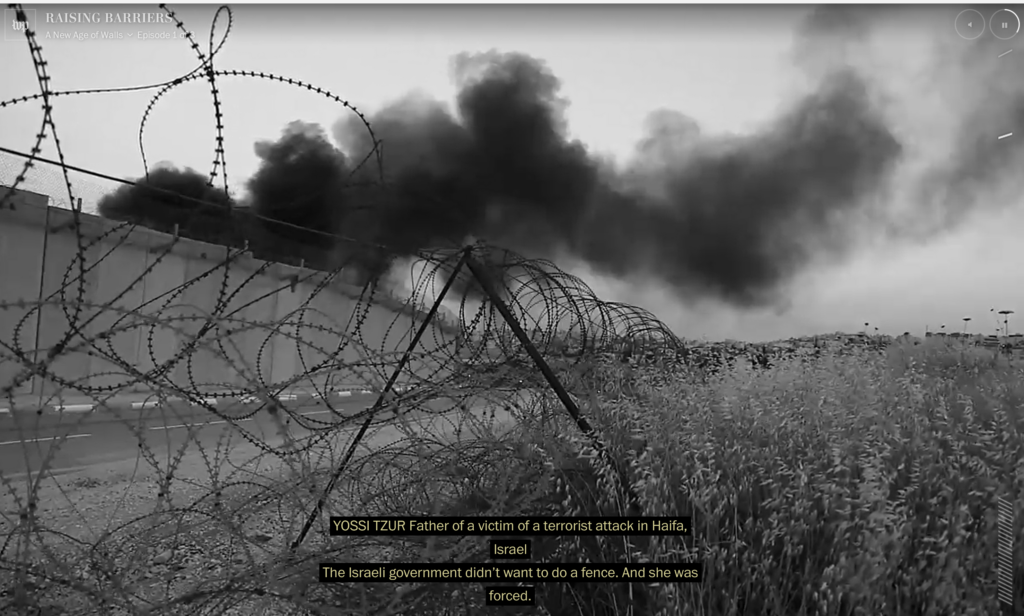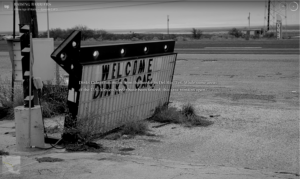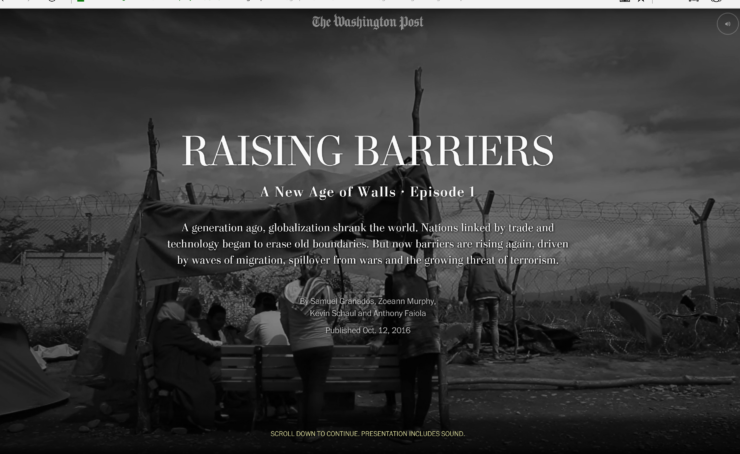In our Brave New Distributed World, journalists suffer from a disorienting lack of control.
Lack of control over audiences, over time spent on page, over clicks… the list goes on. The most any digital reporter can do is hope that experimenting with form actually pays off.
The New York Times famously blazed the trail with its Pulitzer-winning “Snowfall” series, which provoked an avalanche of possibilities for the genre of multimedia longform. Since that story grabbed readers four years ago with its continuous scroll and groundbreaking graphics, countless other publications have followed suit, improvising along the way. Just a few examples include “The Waypoint” from The Washington Post, “Love For My Enemies” from the Atavist, and “Greenland is Melting Away,” also from The New York Times.
The effect reminded me of ’90s computer games I used to play as a kid. There’d be a video sequence, and once the sequence was over, your character would stand in the midst of whatever environment he or she had landed in—but now you were in control of the story’s destiny.
It’s a relatively new species undergoing a gradual but fierce evolution—and everyone’s trying to figure out how it works. “A New Age of Walls,” a three-part multimedia series by The Washington Post chronicling the global migrant crisis, pushes this species a step further, taking cues from audience behavior and using those lessons to the story’s advantage.
For this project, the Post opted for a middle ground between text-heavy longform—sought after by editors but consumed only by those disciplined enough to ward off distraction—and full-on multimedia storytelling that flows from one scene to another. On the surface, the latter sounds preferable. But stories like these typically don’t allow for skimming, because developers don’t build many controls into the navigation.

So the Post team decided to give their readers a bit more control by making the story scrollable. While experiencing “A New Age of Walls,” you can click through to different sections of the story, or backtrack to rewatch previous portions of an “episode,” or chapter.
What sets this project apart is that even though the entire story is scrollable, its tempo varies depending on where you are in the story and how much time you take. For instance, many of the video components play at first without signaling to the reader how to click through to the next bit; then, after an initial run, a “scroll” icon pops up at the bottom of the screen as the video plays again.
It’s a subtle but brilliant strategy: I found that it gave me the freedom to watch each video and listen to its sounds over and over if I wanted to (I could go at my own pace) OR I could scroll through to other parts of the story at any time—but it also stopped me from submitting to the temptation to speed through and rush the storytelling.
The effect reminded me of ’90s computer games I used to play as a kid. There’d be a video sequence, and once the sequence was over, your character would stand in the midst of whatever environment he or she had landed in—but now you were in control of the story’s destiny. This passing of the baton made advancing the game’s plot even more exciting; in “A New Age of Walls,” it’s a hat-tip to your own control—it gives you the chance to decide when the story is ready to move forward.
For example, in the first episode of “A New Age of Walls,” titled Raising Barriers, we are introduced to Dinks Café in Del Rio, Texas—a small town near the border with Mexico. Lights on the sign out front blink (the “e” on “café” is notably slanted). A Texas flag billows softly in the breeze. A lone car cruises by. These moments are interesting the first time they’re played; the second time, they’re almost subversive—as if the story is insisting to the reader that yes, this place is real, the people who gather at Dinks live and breathe border conflict. It hangs in the air.

In fact, so much of what “A New Age of Walls” does well has to do with the senses, especially sound. Throughout the story’s three episodes, birds chirp near border fences, footsteps pass in the brush, children shout from the centers of migrant camps. Sound can take time to absorb, and this is what makes “A New Age of Walls” so great: It treats sound as its own story.
Of course, you don’t need the audio to comprehend the overall message. But the presence of these sounds—an ostinato against the bleakness of struggle—changes the meaning of the words, and gives readers the opportunity to pause and think.
One of the successes of “A New Age of Walls” is the way it deals with information (beyond just graphs and charts).
First, the creators begin with a sweeping overview of the situation in the U.S. today—after our stop at Dinks Café, we meet a Honduran migrant who is waiting for his chance to cross the Rio Grande. Then we cross the ocean to Europe, a continent that has long been dealing with these issues. We meet an Algerian migrant who wants to reach Germany—if he can make it alive. After that, we zoom into the Israeli-Palestinian conflict (perhaps the most heated of them all).
In the second episode, Fenced Out, we get a closer look at Europe’s humanitarian crisis at crowded border control posts, and through longer journeys, like that of a Syrian refugee named Mamo. She and her four sisters managed to make it all the way from Aleppo to Vienna. The third episode, Concrete Divisions, brings us back to the U.S. with a newfound understanding of the complexity of the situation: We hear what Mexicans think of Donald Trump, we become familiar with the rugged border terrain, we meet people whose lives are affected by the construction of fences.
But the most obvious thing that distinguishes “A New Age of Walls” is that’s rendered entirely in black-and-white. In Raising Barriers, we watch a grayscale montage of recent speeches by world political figures from Trump to Boris Johnson to Marine Le Pen. This makes it feel like a documentary, and strikes a retrospective chord—as though we were analyzing these events from a moment in the future, looking back on today. Just as the story plays with time through its creative use of video and audio, it also reminds us that the events of today will be interpreted differently tomorrow. This is a story that reports not on the past, but on the present—with an eye toward the judgmental, reflective lens of history.



